Abstract
We investigated mammary gland differentiation and cell proliferation in rats after acute exposure to xenoestrogens. Pubertal female Sprague-Dawley rats (six/group) were treated for 1 week with diethylstilbestrol (DES), genistein, o,p'-DDT, Aroclor 1221, Aroclor 1254, 2,3,7,8-tetrachlorodibenzo-p-dioxin (TCDD), or the vehicle, sesame oil. Animals were killed 18 hr after the last treatment. Analysis of mammary whole-mounts revealed that exposure to DES, genistein, and o,p'-DDT resulted in enhanced gland differentiation and increased epithelial cell proliferation as measured by proliferating cell nuclear antigen immunohistochemistry, TCDD treatment inhibited cell proliferation and gland development. Aroclor 1221 and Aroclor 1254 treatments had slight but not statistically significant effects on cell proliferation and mammary gland development. We conclude that DES, genistein, and o,p'-DDT given to pubertal rats act as morphogens; i.e., they increase cell proliferation, which promotes maturation of the undifferentiated terminal end buds to more differentiated lobular terminal ductal structures.
Full text
PDF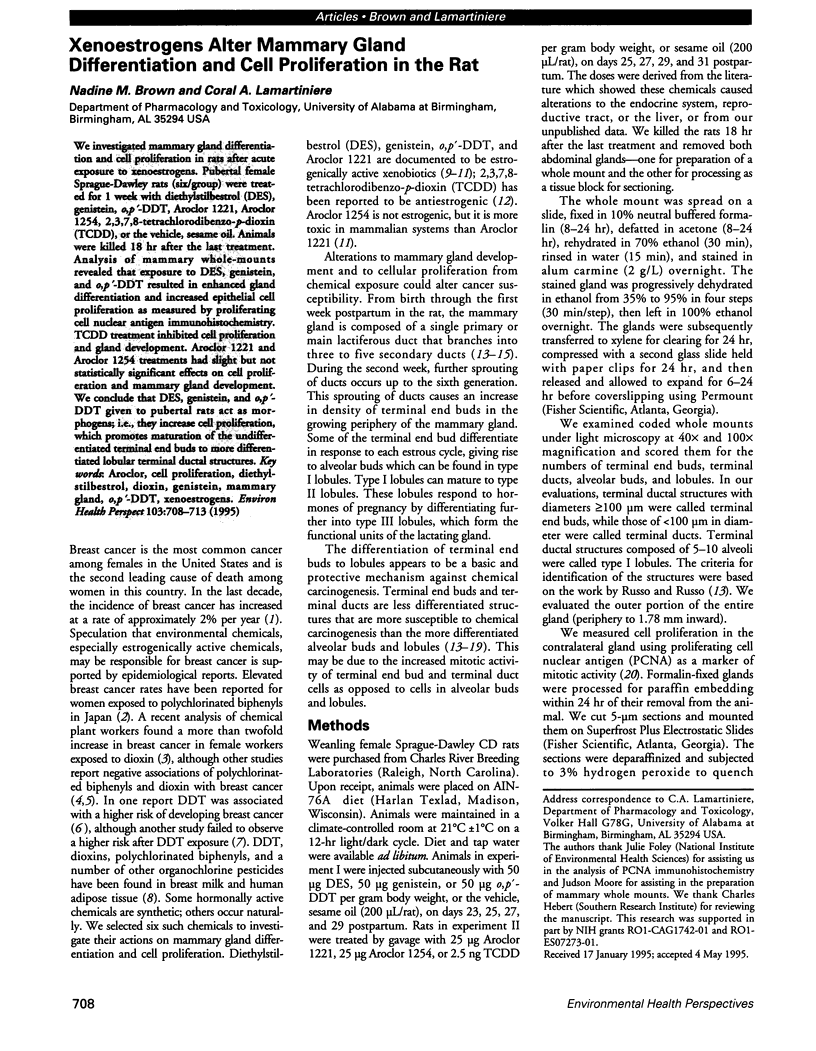
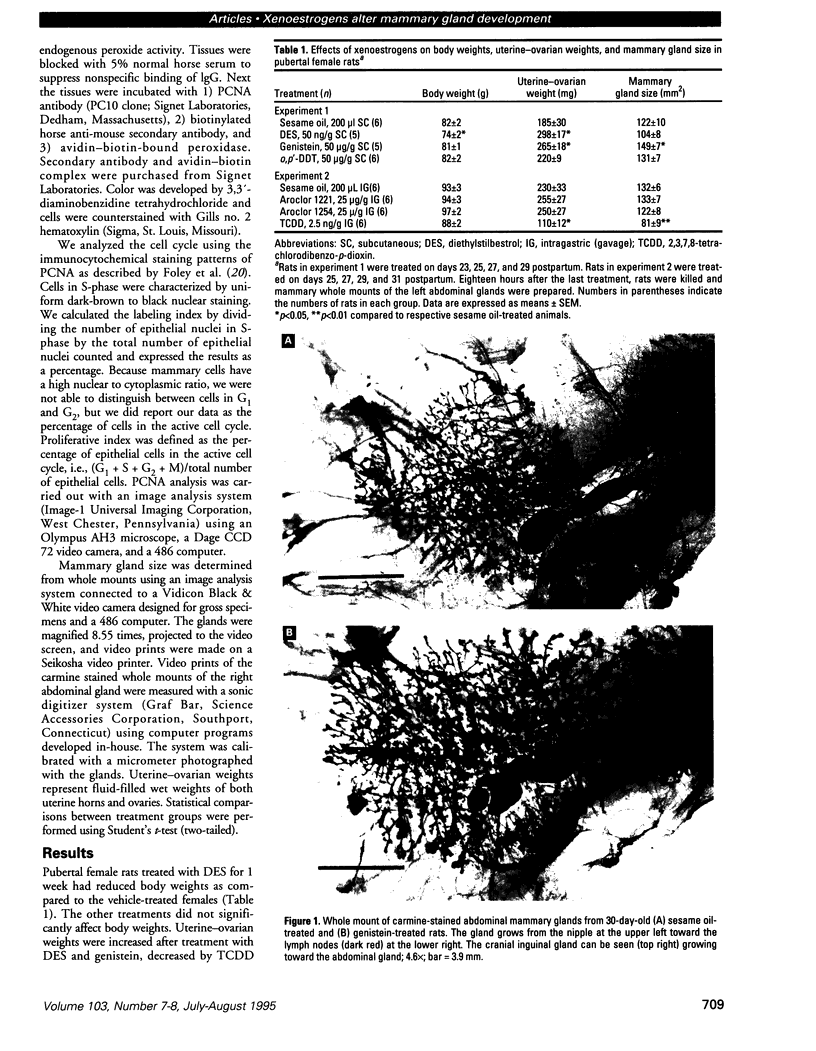
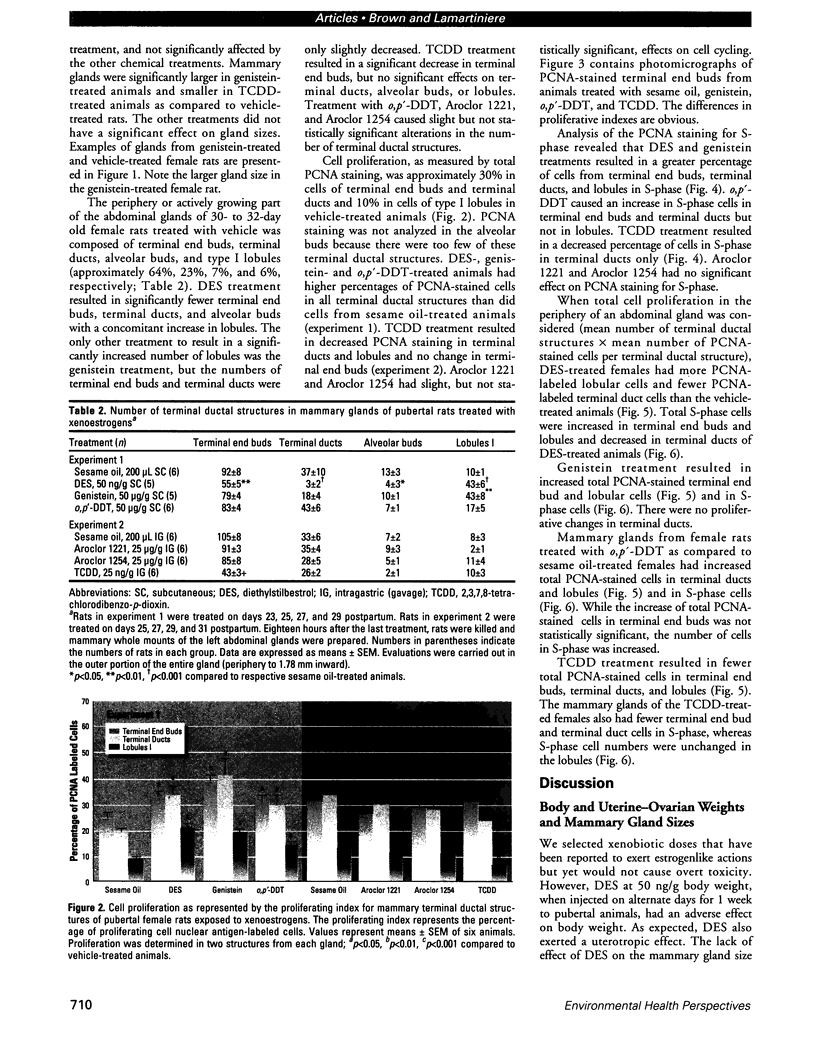
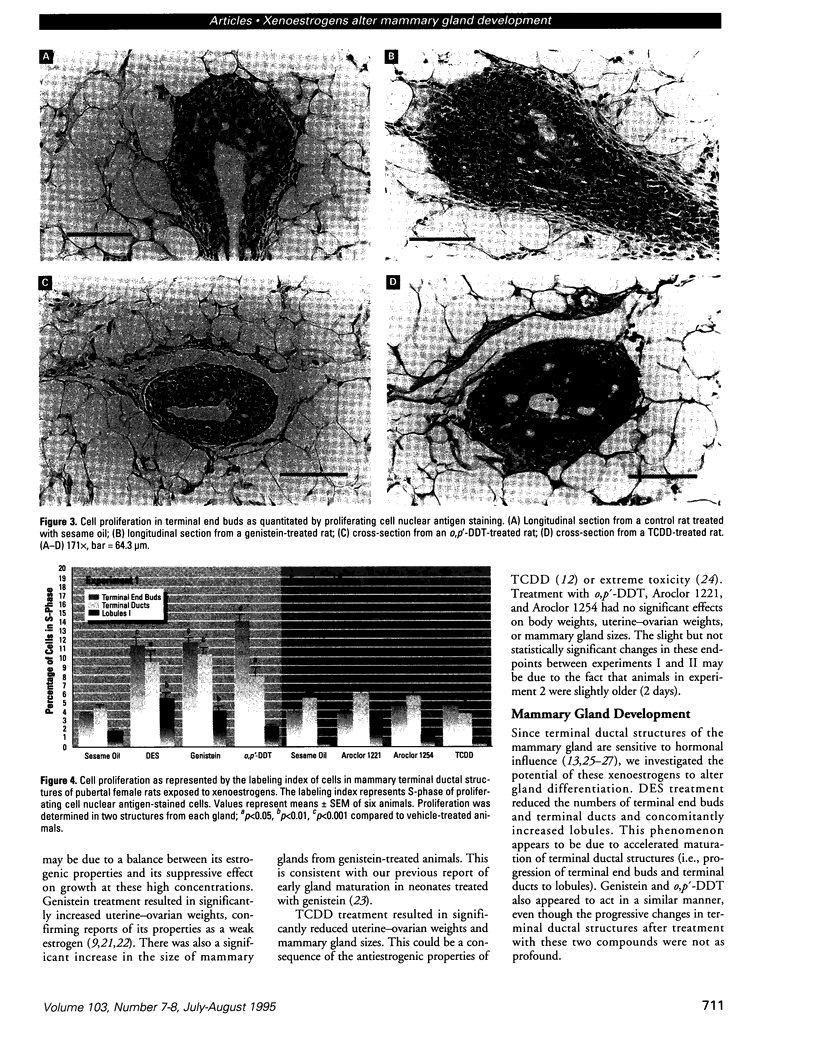

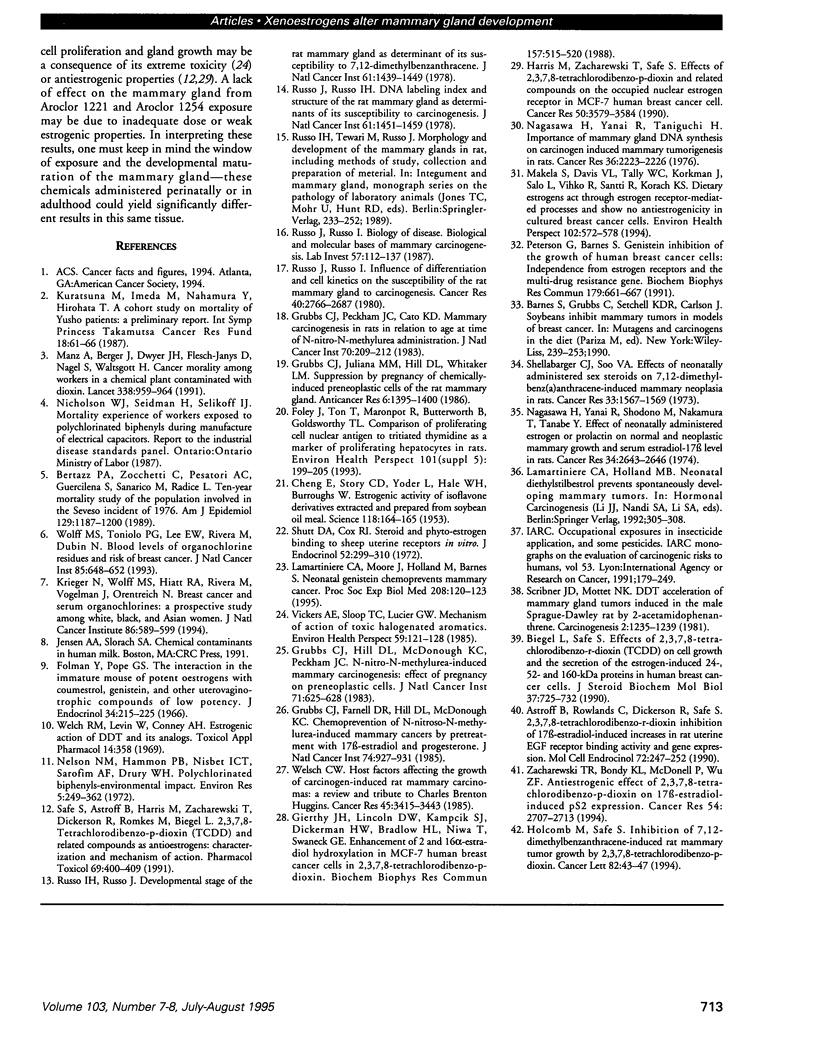
Images in this article
Selected References
These references are in PubMed. This may not be the complete list of references from this article.
- Astroff B., Rowlands C., Dickerson R., Safe S. 2,3,7,8-Tetrachlorodibenzo-p-dioxin inhibition of 17 beta-estradiol-induced increases in rat uterine epidermal growth factor receptor binding activity and gene expression. Mol Cell Endocrinol. 1990 Sep 10;72(3):247–252. doi: 10.1016/0303-7207(90)90149-3. [DOI] [PubMed] [Google Scholar]
- Bertazzi P. A., Zocchetti C., Pesatori A. C., Guercilena S., Sanarico M., Radice L. Ten-year mortality study of the population involved in the Seveso incident in 1976. Am J Epidemiol. 1989 Jun;129(6):1187–1200. doi: 10.1093/oxfordjournals.aje.a115240. [DOI] [PubMed] [Google Scholar]
- Biegel L., Safe S. Effects of 2,3,7,8-tetrachlorodibenzo-p-dioxin (TCDD) on cell growth and the secretion of the estrogen-induced 34-, 52- and 160-kDa proteins in human breast cancer cells. J Steroid Biochem Mol Biol. 1990 Dec 10;37(5):725–732. doi: 10.1016/0960-0760(90)90357-q. [DOI] [PubMed] [Google Scholar]
- CHENG E., STORY C. D., YODER L., HALE W. H., BURROUGHS W. Estrogenic activity of isoflavone derivatives extracted and prepared from soybean oil meal. Science. 1953 Aug 7;118(3058):164–165. doi: 10.1126/science.118.3058.164. [DOI] [PubMed] [Google Scholar]
- Foley J., Ton T., Maronpot R., Butterworth B., Goldsworthy T. L. Comparison of proliferating cell nuclear antigen to tritiated thymidine as a marker of proliferating hepatocytes in rats. Environ Health Perspect. 1993 Dec;101 (Suppl 5):199–205. doi: 10.1289/ehp.93101s5199. [DOI] [PMC free article] [PubMed] [Google Scholar]
- Folman Y., Pope G. S. The interaction in the immature mouse of potent oestrogens with coumestrol, genistein and other utero-vaginotrophic compounds of low potency. J Endocrinol. 1966 Feb;34(2):215–225. doi: 10.1677/joe.0.0340215. [DOI] [PubMed] [Google Scholar]
- Gierthy J. F., Lincoln D. W., 2nd, Kampcik S. J., Dickerman H. W., Bradlow H. L., Niwa T., Swaneck G. E. Enhancement of 2- and 16 alpha-estradiol hydroxylation in MCF-7 human breast cancer cells by 2,3,7,8-tetrachlorodibenzo-P-dioxin. Biochem Biophys Res Commun. 1988 Dec 15;157(2):515–520. doi: 10.1016/s0006-291x(88)80279-1. [DOI] [PubMed] [Google Scholar]
- Grubbs C. J., Farnell D. R., Hill D. L., McDonough K. C. Chemoprevention of N-nitroso-N-methylurea-induced mammary cancers by pretreatment with 17 beta-estradiol and progesterone. J Natl Cancer Inst. 1985 Apr;74(4):927–931. [PubMed] [Google Scholar]
- Grubbs C. J., Hill D. L., McDonough K. C., Peckham J. C. N-nitroso-N-methylurea-induced mammary carcinogenesis: effect of pregnancy on preneoplastic cells. J Natl Cancer Inst. 1983 Sep;71(3):625–628. [PubMed] [Google Scholar]
- Grubbs C. J., Juliana M. M., Hill D. L., Whitaker L. M. Suppression by pregnancy of chemically induced preneoplastic cells of the rat mammary gland. Anticancer Res. 1986 Nov-Dec;6(6):1395–1400. [PubMed] [Google Scholar]
- Grubbs C. J., Peckham J. C., Cato K. D. Mammary carcinogenesis in rats in relation to age at time of N-nitroso-N-methylurea administration. J Natl Cancer Inst. 1983 Jan;70(1):209–212. [PubMed] [Google Scholar]
- Harris M., Zacharewski T., Safe S. Effects of 2,3,7,8-tetrachlorodibenzo-p-dioxin and related compounds on the occupied nuclear estrogen receptor in MCF-7 human breast cancer cells. Cancer Res. 1990 Jun 15;50(12):3579–3584. [PubMed] [Google Scholar]
- Holcomb M., Safe S. Inhibition of 7,12-dimethylbenzanthracene-induced rat mammary tumor growth by 2,3,7,8-tetrachlorodibenzo-p-dioxin. Cancer Lett. 1994 Jul 15;82(1):43–47. doi: 10.1016/0304-3835(94)90144-9. [DOI] [PubMed] [Google Scholar]
- Krieger N., Wolff M. S., Hiatt R. A., Rivera M., Vogelman J., Orentreich N. Breast cancer and serum organochlorines: a prospective study among white, black, and Asian women. J Natl Cancer Inst. 1994 Apr 20;86(8):589–599. doi: 10.1093/jnci/86.8.589. [DOI] [PubMed] [Google Scholar]
- Kuratsune M., Ikeda M., Nakamura Y., Hirohata T. A cohort study on mortality of "yusho" patients: a preliminary report. Princess Takamatsu Symp. 1987;18:61–66. [PubMed] [Google Scholar]
- Lamartiniere C. A., Moore J., Holland M., Barnes S. Neonatal genistein chemoprevents mammary cancer. Proc Soc Exp Biol Med. 1995 Jan;208(1):120–123. doi: 10.3181/00379727-208-43843. [DOI] [PubMed] [Google Scholar]
- Makela S, Davis VL, Tally WC, Korkman J, Salo L, Vihko R, Santti R, Korach KS. Dietary Estrogens Act through Estrogen Receptor-Mediated Processes and Show No Antiestrogenicity in Cultured Breast Cancer Cells. Environ Health Perspect. 1994 Jun;102(6-7):572–578. doi: 10.1289/ehp.94102572. [DOI] [PMC free article] [PubMed] [Google Scholar]
- Manz A., Berger J., Dwyer J. H., Flesch-Janys D., Nagel S., Waltsgott H. Cancer mortality among workers in chemical plant contaminated with dioxin. Lancet. 1991 Oct 19;338(8773):959–964. doi: 10.1016/0140-6736(91)91835-i. [DOI] [PubMed] [Google Scholar]
- Nagasawa H., Yanai R., Shodono M., Nakamura T., Tanabe Y. Effect of neonatally administered estrogen or prolactin on normal and neoplastic mammary growth and serum estradiol-17 beta level in rats. Cancer Res. 1974 Oct;34(10):2643–2646. [PubMed] [Google Scholar]
- Nagasawa H., Yanai R., Taniguchi H. Importance of mammary gland DNA synthesis on carcinogen-induced mammary tumorigenesis in rats. Cancer Res. 1976 Jul;36(7 Pt 1):2223–2226. [PubMed] [Google Scholar]
- Peterson G., Barnes S. Genistein inhibition of the growth of human breast cancer cells: independence from estrogen receptors and the multi-drug resistance gene. Biochem Biophys Res Commun. 1991 Aug 30;179(1):661–667. doi: 10.1016/0006-291x(91)91423-a. [DOI] [PubMed] [Google Scholar]
- Polychlorinated biphenyls--environmental impact. A review by the Panel on Hazardous Trace Substances, March 1972. Environ Res. 1972 Sep;5(3):249–362. [PubMed] [Google Scholar]
- Russo I. H., Russo J. Developmental stage of the rat mammary gland as determinant of its susceptibility to 7,12-dimethylbenz[a]anthracene. J Natl Cancer Inst. 1978 Dec;61(6):1439–1449. [PubMed] [Google Scholar]
- Russo J., Russo I. H. Biological and molecular bases of mammary carcinogenesis. Lab Invest. 1987 Aug;57(2):112–137. [PubMed] [Google Scholar]
- Russo J., Russo I. H. DNA labeling index and structure of the rat mammary gland as determinants of its susceptibility to carcinogenesis. J Natl Cancer Inst. 1978 Dec;61(6):1451–1459. [PubMed] [Google Scholar]
- Russo J., Russo I. H. Influence of differentiation and cell kinetics on the susceptibility of the rat mammary gland to carcinogenesis. Cancer Res. 1980 Aug;40(8 Pt 1):2677–2687. [PubMed] [Google Scholar]
- Safe S., Astroff B., Harris M., Zacharewski T., Dickerson R., Romkes M., Biegel L. 2,3,7,8-Tetrachlorodibenzo-p-dioxin (TCDD) and related compounds as antioestrogens: characterization and mechanism of action. Pharmacol Toxicol. 1991 Dec;69(6):400–409. doi: 10.1111/j.1600-0773.1991.tb01321.x. [DOI] [PubMed] [Google Scholar]
- Scribner J. D., Mottet N. K. DDT acceleration of mammary gland tumors induced in the male Sprague-Dawley rat by 2-acetamidophenanthrene. Carcinogenesis. 1981;2(12):1235–1239. doi: 10.1093/carcin/2.12.1235. [DOI] [PubMed] [Google Scholar]
- Shellabarger C. J., Soo V. A. Effects of neonatally administered sex steroids on 7,12-dimethylbenz(a)anthracene-induced mammary neoplasia in rats. Cancer Res. 1973 Jul;33(7):1567–1569. [PubMed] [Google Scholar]
- Shutt D. A., Cox R. I. Steroid and phyto-oestrogen binding to sheep uterine receptors in vitro. J Endocrinol. 1972 Feb;52(2):299–310. doi: 10.1677/joe.0.0520299. [DOI] [PubMed] [Google Scholar]
- Vickers A. E., Sloop T. C., Lucier G. W. Mechanism of action of toxic halogenated aromatics. Environ Health Perspect. 1985 Feb;59:121–128. doi: 10.1289/ehp.59-1568090. [DOI] [PMC free article] [PubMed] [Google Scholar]
- Welch R. M., Levin W., Conney A. H. Estrogenic action of DDT and its analogs. Toxicol Appl Pharmacol. 1969 Mar;14(2):358–367. doi: 10.1016/0041-008x(69)90117-3. [DOI] [PubMed] [Google Scholar]
- Welsch C. W. Host factors affecting the growth of carcinogen-induced rat mammary carcinomas: a review and tribute to Charles Brenton Huggins. Cancer Res. 1985 Aug;45(8):3415–3443. [PubMed] [Google Scholar]
- Wolff M. S., Toniolo P. G., Lee E. W., Rivera M., Dubin N. Blood levels of organochlorine residues and risk of breast cancer. J Natl Cancer Inst. 1993 Apr 21;85(8):648–652. doi: 10.1093/jnci/85.8.648. [DOI] [PubMed] [Google Scholar]
- Zacharewski T. R., Bondy K. L., McDonell P., Wu Z. F. Antiestrogenic effect of 2,3,7,8-tetrachlorodibenzo-p-dioxin on 17 beta-estradiol-induced pS2 expression. Cancer Res. 1994 May 15;54(10):2707–2713. [PubMed] [Google Scholar]












